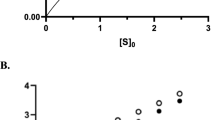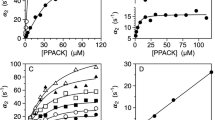Abstract
It has been assumed that the structure of a single inhibitor complex is sufficient to define the available subsites of an enzyme that has a unique binding site and a uniquely defined mode for ligand binding — the specificity for these subsites can thus be probed by kinetic experiments. Elastase is an enzyme for which these traditional assumptions, which underlie such structural and kinetic studies, do not hold. Three new crystal structures of elastase complexed to chemically similar inhibitors with similar binding affinities reveal a diversity of binding modes as well as two new subsites on elastase. The existence of multiple binding sites and different binding modes for such similar inhibitors indicates that researchers must proceed with caution when using kinetics to map out protein subsites.
This is a preview of subscription content, access via your institution
Access options
Subscribe to this journal
Receive 12 print issues and online access
$189.00 per year
only $15.75 per issue
Buy this article
- Purchase on Springer Link
- Instant access to full article PDF
Prices may be subject to local taxes which are calculated during checkout
Similar content being viewed by others
References
Kraut, J. Serine proteases: Structure and Mechanism of Catalysis. A. Rev. Biochem. 46, 331–358 (1977).
Geokas, M.C., Murphy, R., McKenna, R.D. The role of elastase in acute pancreatitis I. Intrapancreatic elastolytic activity in bile-induced acute pancreatitis in dogs. Archs. Path., 86, 117–126 (1968).
Burchardi, H. et al., Adult Respiratory Distress Syndrome (ARDS); Experimental models with elastase and thrombin infusion in pigs. Adv., expt. med. Biol., 167, 319–333 (1984).
Mittman, C. Pulmonary Emphysema and Proteolysis, 1–537 (Academic, New York, 1971).
Powers, J.C. Inhibitors of elastase and pulmonary emphysema. Trends biochem. Sci. 1, 211–214 (1976).
Davis, P.B. Text Book of Cystic Fibrosis ed. Lloyd-Still, J.D. 351–369 (John Wright PSG Inc., Boston, (1983).
Atlas, D. The active Site of Porcine Elastase. J. molec. Biol., 93, 39–53 (1975).
Takahashi, L.H. et al., X-Ray Diffraction Analysis of the Inhibition of Porcine Pancreatic Elastase by a Peptidyl Trifluoromethylketone. J. molec. Biol., 201, 423–428 (1988).
Shotton, D.M., White, N.J. and Watson, H.C., Changes and Inhibitor Binding at the Active Site of Elastase. Cold Spring Harbor Simp. quant. Biol., 36, 91–105 (1972).
Hughes, D.L. et al., Crystallographic Study of the Binding of a Trifluoroacetyl Dipeptide Anilide Inhibitor with Elastase. J. molec. Biol., 162, 645 (1982).
Meyer, E.F. et al., Structure of the Product COmplex of Acetyl-Ala-Pro-Ala with Porcine Pancreatic Elastase at 1.65 Å Resolution. J. molec. Biol., 189, 533–539 (1986).
Sierra, I.L. Interaction of the Peptide CF3-Leu-Ala-NH-C6H4-CF3 (TFLA) with Porcine Pancreatic Elastase. X-Ray studies at 1.8 Å. Molec. Recognition, 3, 36–44 (1990).
Renaud, A. et al. Mapping of the S′ Subsites of Porcine Pancreatic and Human Leukocyte Elastases. J. biol. Chem., 258, 8312–8316 (1983).
Meyer, E.F. et al., Structure of Native Porcine Pancreatic Elastase at 1.65 Å Resolution. Acta Crystallogr. B44, 26–38 (1988).
Shoichet, B.K. Structure-Based Discovery of Inhibitors of Thymidylate Synthase. et al., Science, 259, 1445–1449 (1993).
Wojtczak, A. et al., Mechanism of Melecular Recognition. Structural Aspects of 3,3′-diiodo-L-Thyronine Binding to Human Serum. J. biol. Chem., 267, 353–357 (1992).
Wright, C.S. et al. Crystal Structure of a Subtilisin BPN' Complex with N-Benzoyl-L-Arginine. J. molec. Biol., 66, 283–289 (1972).
Goodford, P.J. A Computational Procedure for Determining Energetically Favorable Binding Sites on Biologically Important Macromolecules. J. med. Chem., 28, 849 (1985).
Miranker, A. and Karplus, M., Funcationality Maps of Binding Sites: A Multiple Copy Simultaneous Search Method. Proteins, 11, 29–34 (1991).
Caflisch, A. et al., Multiple Copy Simultaneous Search and construction of Ligands in Binding Sites: Application to Inhibitors of HIV-1 Aspartic Proteinase. J med. Chem, 36, 2142–2167 (1993).
Fitzpatrick, P.A. et al., Enzyme crystal structure in a neat organic solvent. Proc. natn. Acad. Sci. U.S.A., 90, 8653–8657 (1993).
Kabsch, W. Evaluation of Single-Crystal X-ray Diffraction Data from a Positron-Sensitive Detector. J. appl. Crystallogr. 21, 916 (1988).
Hendrickson, W.A. and Konnert, J.H. Computing in Crystallography, (eds Diamond, R., Ramaseshan, S. & Venkatesan, K.) 13.01–13.23 (Indian Academy of Sciences, Bangalore, 1980)
Brunger, A.T. Crystallographic Computing 4. Techniques and New Technologies (eds Isaacs, N. W. & Taylor, M.R.) 126–140 (Oxford Univ. Press., Oxford, 1988).
Burley, S.K. and Petsko, G.A., Weakly polar Interactions in Proteins. Adv. protein Chem., 39, 125–189, (1988).
Author information
Authors and Affiliations
Rights and permissions
About this article
Cite this article
Mattos, C., Rasmussen, B., Ding, X. et al. Analogous inhibitors of elastase do not always bind analogously. Nat Struct Mol Biol 1, 55–58 (1994). https://doi.org/10.1038/nsb0194-55
Received:
Accepted:
Issue Date:
DOI: https://doi.org/10.1038/nsb0194-55



